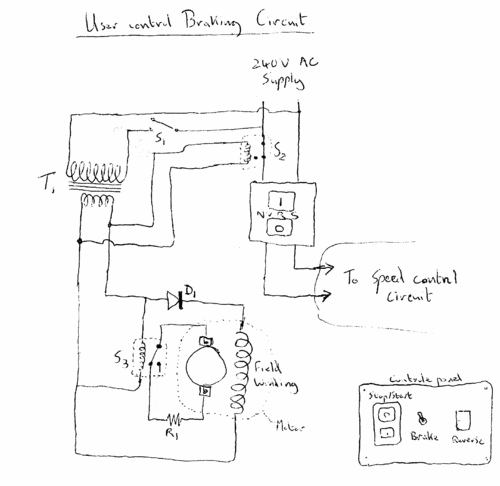4– Electronic Braking
But it is nice to have the option of braking, rather than have it always imposed… Three reasons:
1. You might not always want it to rush to a halt – doing so puts extra strain on the belt, bearings and other components. In unusual circumstances, It might also endanger your work piece to have a dramatic change of speed.
2. Almost all electronic braking (on series motors) works by shorting the brushes together with a resistor – effectively turning the motor into a generator. This creates a braking force and the energy is dissipated as heat in the armature. Meaning that a lot of stopping and starting with full braking being applied can overheat the motor.
3. It is simply more fun to be able to control things.
One difficulty with this type of motor is that the field coil must remain energized for braking to work.. This is a problem because in general we want braking to coincide with a cut in the power to the unit.
My solution, is to have a push button (S1), normally open, that, when pushed (and held down), makes a separate circuit that both powers the field coil and energizes a solenoid relay (S3), which shorts the brushes through resistor R1.
Key to diagram:
S1 = Push switch – the main switch that the user pushes, and holds, to cause braking.
S2 = A relay that gets power and therefore energizes, when S1 is pressed. It cuts power to the NVRS
S3 = Another relay that, when energized, completes a short circuit between the motor brushes.
NVRS = The main on/off “no volt release switch”.
R1 = A resistor of about 10ohms (the larger the value the more gentle the braking effect)
T1 = Step down transformer 240V to about 9V
D1 = A diode that ensures the field coil is maintained in one direction.

December 24th, 2010 at 12:23 pm
Hi I’m doing the same type off motor but not shore about the brushes, which way do i connect them i got white and blue wires im not shore if they should both go to a live wire or not? could anyone help me out on this please thanks
mark
December 26th, 2010 at 12:28 pm
Hi Mark, it is not that clear what the problem is from your comment. Have you checked out and read through the first few steps of motor control (they start here)?
November 15th, 2012 at 3:40 pm
Hi Bongo.
Another question. Can you post my a complete scheme because i do not understand the connection with the previous part (speed control and the motor) and the part above so the brake.
Thank you again
Fabio
November 16th, 2012 at 10:55 am
Hi Fabio,
Think of the braking circuit as completely separate to the speed control. The NVRS provides power to the speed control circuit – that’s the only connection it has to this circuit.
November 16th, 2012 at 11:16 am
HI Bongo.
Sorry again but i understood (maybe i’m wrong) that the speed control circuit was connected to the field and armature coil of the motor and then also the braking circuit was connected on the same coil.
Is that right and so the 2 circuit (speed and braking) was connected in parallel to the same coil?
Thank you again
Fabio
November 16th, 2012 at 11:27 am
Fab, you are right. But when the braking circuit is activated the speed control circuit is turned off (by the relay S2). So all the braking circuit is doing is: 1. cutting power to the speed control circuit, 2. putting power through the field coils and 3. shorting out the two brushes (with a resistor in between). Make sense?
November 16th, 2012 at 11:30 am
Yes man. I desire only to be sure that both circuit is connected on the same coil in parallel and, of course, when the speed circuit is ON, it give all the power to the coils and the braking circuit is OFF.
Viceversa when the braking circuit i s ON, it give all the power to the coils and the speed circuit is OFF.
Thank you again Bongo
November 16th, 2012 at 11:38 am
That’s right! There is almost certainly a clever way to design it so that you don’t use a separate transformer for speed control and another to keep the field coils energised when breaking… If you suss one out, post up the circuit diagram ;)